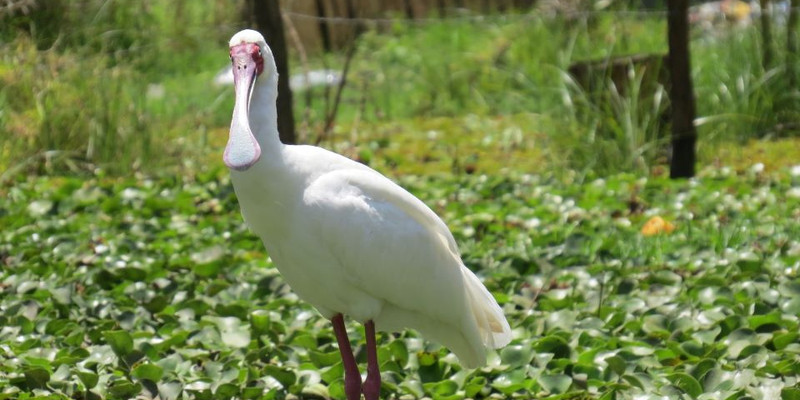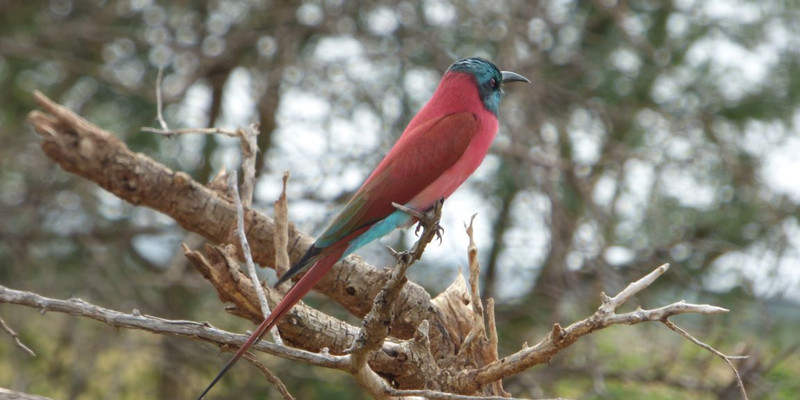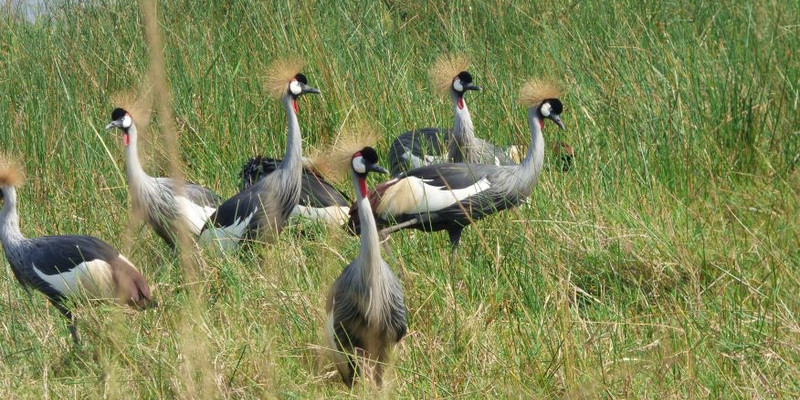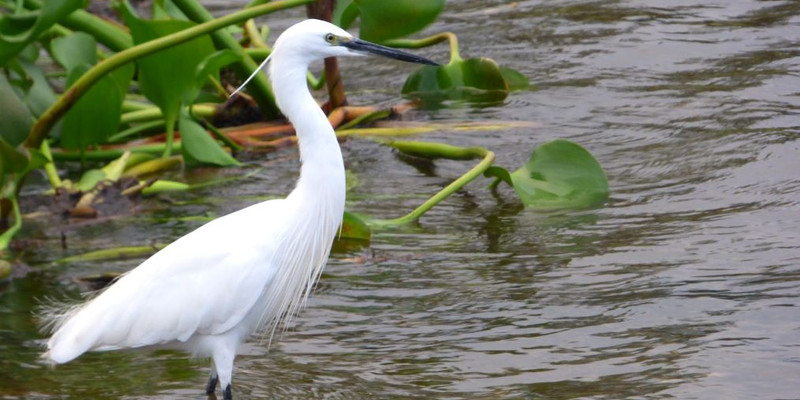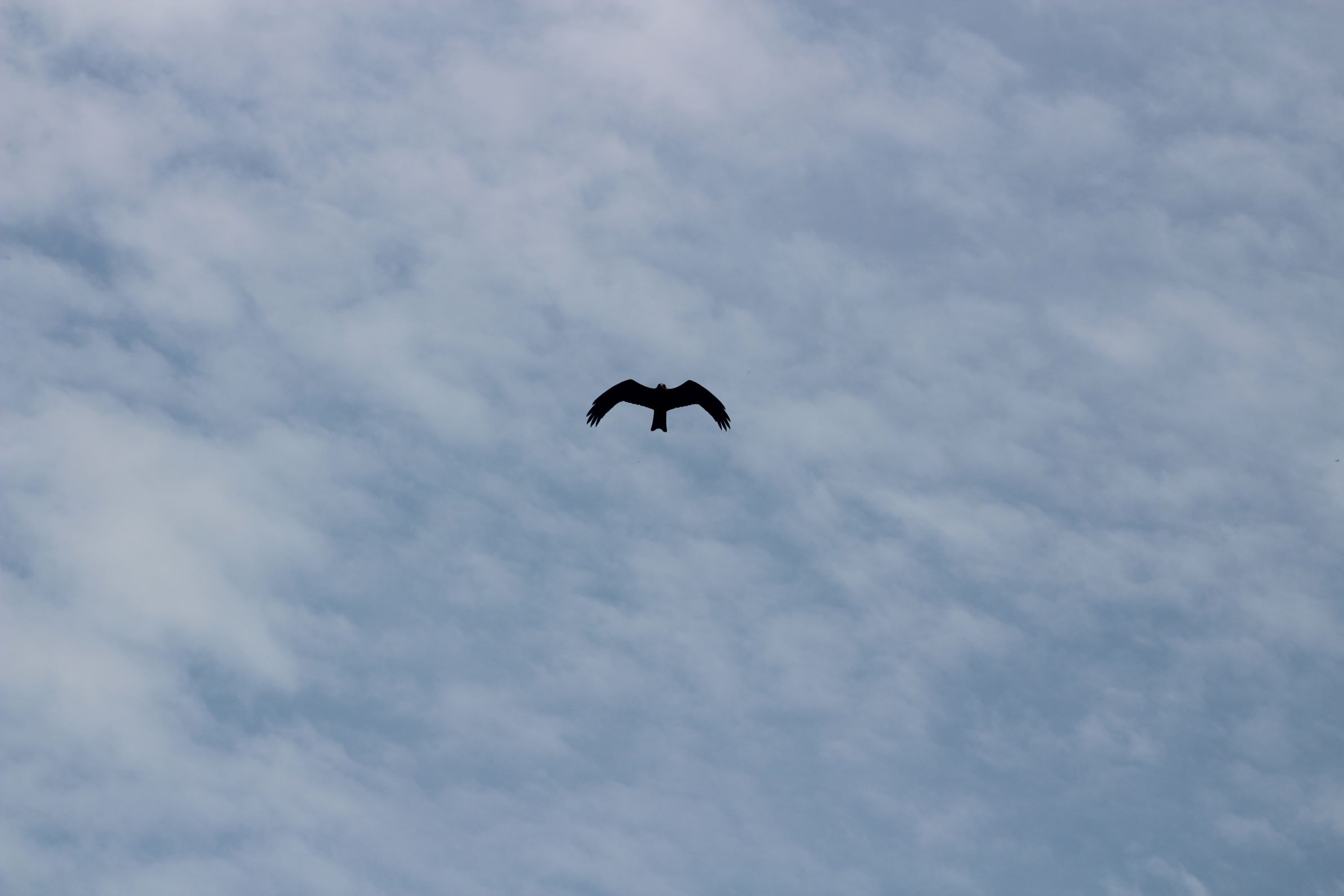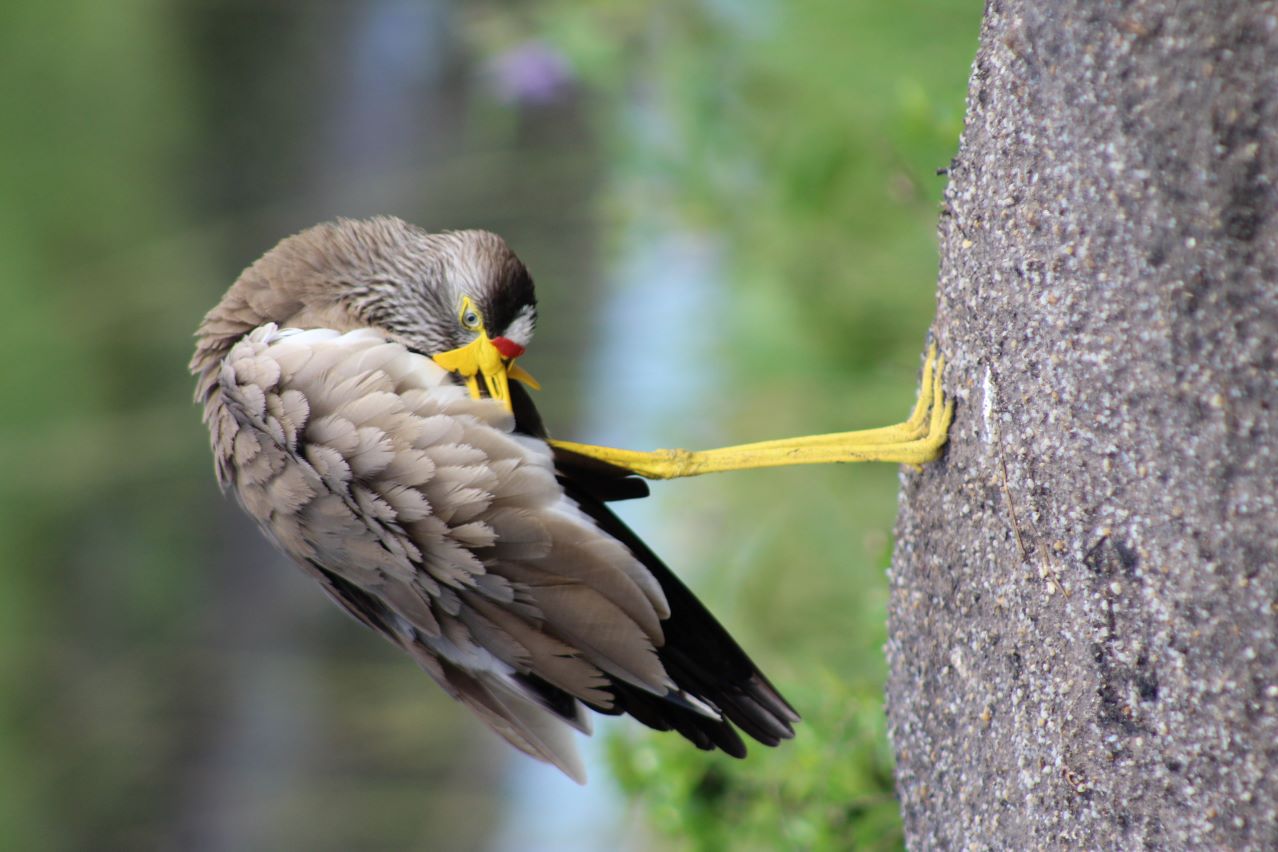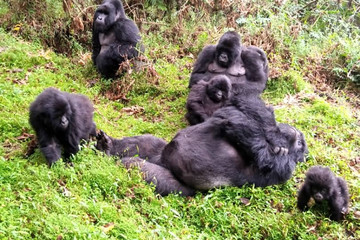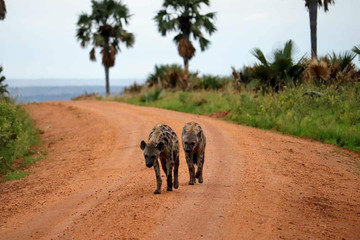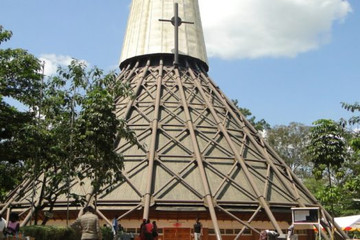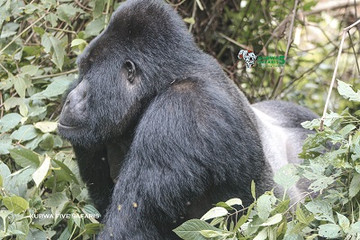20 days uganda birding safari for albertine rift endemics

TOUR DESCRIPTION
This Uganda birding safari for Albertine endemics is a perfect adventure for avid birders. On this 20-day trip, you will be able to spot most (if not all) of the 1000+ bird species that live in Uganda – making it a true birder’s paradise.
From the Swamps, savannahs, farmlands, forests, and lakes your journey will not be like any other safari. On this birding trip, you will visit Mabamba, Mgahinga, Bwindi, Rwenzori, Semuliki, Kibale, and Kidepo among others. You will see birds like shoebills, nightjars, sunbirds, broadbills, storks, finches, eagles, ostriches, and much more.
Beyond the birds, you can choose to add gorilla tracking (since you will already be there), and of course, you will have many opportunities to engage with locals and experience the culture.
Take a closer look at the detailed itinerary for a more in-depth understanding of how such a birding safari would work out for you. Keep in mind that all our trips are fully customizable and we can personalize them to meet your specific needs.
Habitats
This trip will take you through the following wild habitats in search of birds.
Papyrus Swamps
Riverine Forest
Lakes
Acacia Savanna
Moist woodland
Grassland
Agricultural lands
Borassus Palm Savannah
Forest
Optional Activities
- Golden Monkey Tracking ($60)
- Gorilla Tracking ($700)
Detailed Itinerary
Day 1: Airport Transfer
On arrival at Entebbe international airport, you will be received by your guide and transferred to your hotel in Entebbe. Depending on your arrival time, you will have the opportunity to bird the Entebbe botanical gardens as an introduction to Uganda birding for a variety of species.
Accommodation: The Boma Hotel
Meal plan: Dinner
Day 2: Birding at Mabamba Swamp and Transfer to Lake Mburo
After an early breakfast, we bird to Mabamba – Kamengo Wetlands about 50km west of the Entebbe area on the shores of Lake Victoria. This is one of the few remaining swamps in Uganda protected by the local communities – an extensive papyrus swamp with its labyrinth of channels and lagoons, classified as an IBA (Important Bird Area) and home to several pairs of Shoebills, Uganda’s most famous avian resident.
This charismatic species, the only representative in its family, is undoubtedly amongst the most sought-after birds in Africa and we’ll make special efforts today to find it by paddling through the channels by canoe.
There will of course be a good selection of classic East African water birds: Pink-backed Pelican, African Marsh-Harrier, Long-toed Plover, Long-tailed Cormorant, Yellow-billed Duck, Blue-breasted Bee-eater, Goliath Heron, African Water Rail, Blue-headed Coucal, African Fish-Eagle, Allen’s Gallinule, Papyrus Canary, Malachite Kingfisher, Swamp Flycatcher, Papyrus Gonolek, White-winged Warblers, Papyrus Yellow Warblers.
Other areas in and around Entebbe and Kampala may produce African Open-billed Stork, Grey Kestrel, Eastern Grey Plantain-Eater, African Green Pigeon, Black-and-white Shrike-flycatcher, or maybe the rare Weyn’s Weaver.
You will then continue to Lake Mburo National Park. It is 260 sq. km. and has markedly different fauna from other reserves. It is the only national park that contains an entire lake. Situated in rolling hills and open grassy valleys, the park also consists of 4 other smaller lakes.
Accommodation: Rwakobo Rock Lodge
Meal plan: Breakfast, Lunch, and Dinner
Day 3: Birding en route to Mgahinga Gorilla National Park
Today, after an early breakfast, you will bird to the southwestern corner of Uganda for a beautiful birding experience in Mgahinga Gorilla National Park. Mgahinga Gorilla NP is the country’s most scenic and smallest park.
You shall have several stopovers for birding in specific swampy areas and agricultural lands for unique bird species. You will arrive at your lodge later that evening, looking forward to a full-bird day the next day in Mgahinga Gorilla National Park for the Albertine Rift endemics.
Accommodation: Lake Mulehe Safari Lodge
Meal plan: Breakfast, Lunch, and Dinner
Day 4: Birding in Mgahinga Gorilla National Park
Mgahinga Gorilla National Park has about 180 recorded bird species, which include Albertine Rift endemics. Today you will traverse a variety of montane habitats along the Gorge trail, seeking out the different bird species unique to this region.
Here is a list of some of the birds you will be able to see in Mgahinga Gorilla National Park; The Dusky Turtle Dove, Handsome Francolin, Rwenzori Turaco, Cape Robin-chat, Kivu, Ground Thrush, Rwenzori Batis, Brown-crowned Tchagra, Cinnamon Bracken Warbler, Shelly’s Dusky Crimsonwing, Bronze Sunbird, White Starred Robin, Archer’s Robin-Chat, Black-headed Waxbill, Greater Double Collard Sunbird, Olive Pigeon, Streaky Seedeater, Stripe-breasted Tit, Western Green Tinkerbird, Brown Woodland Warbler, White-starred Robin, Malachite Sunbird
Accommodation: Lake Mulehe Safari Lodge
Meal plan: Breakfast, Lunch, and Dinner
Day 5: Transfer to Bwindi Impenetrable N.P
Bwindi Impenetrable National Park is the richest forest in East Africa in relation to its trees, butterflies, and birds. It is home to more than half of the world’s population of mountain gorillas. The bird list for the park currently totals 347 species. The forest has 10 of the 26 globally threatened species in Uganda, five of which are vulnerable, and boasts 24 of Uganda’s 25 Albertine Rift endemics.
In Ruhija the birds we hope to sight include the; Rwenzori Batis, Montane Sooty Boubou, Shelley’s Crimsonwing, Collared Apalis, White-starred Robin, Mountain Illadopsis, Banded Prinia, Strange Weaver, Archer’s Robin-chat, Mountain Greenbul, Purple-breasted Sunbirds, Regal Sunbirds, Yellow-streaked Greenbul, Blue-headed Sunbirds, Northern Olive Thrush, Abyssinian Crimsonwing, Black-headed Waxbill, Dusky Crimsonwing, Willcock’s Honeyguide, Sharpe’s Starling.
You will have stopovers at Echuya Forest for good birding opportunities and possible sightings of Albertine Rift endemics.
Accommodation: Bakiga Lodge
Meal plan: Breakfast, Lunch, and Dinner
Day 6: Birding in Bwindi – Mubwindi Swamp
Today, you will bird towards Mubwindi Swamp, where the trail drops steeply through the dense forest and then winds through the swampy forest.
Initially, the birds on the trail are similar to those encountered before, but more time spent will provide opportunities for the rare and localized African Green Broadbill, now known as Grauer’s Broadbill. It prefers to nest near the Mubwindi Swamp and can be difficult to locate while on this trip but with excellent site guides, there are high chances of locating it.
Other birds to look out for in this area of Bwindi impenetrable national park are; Yellow-billed Barbet, Pink-footed Puffback, Oriole Finch, Black-billed Turacos, Lagden’s Bush-Shrike, Doherty’s Bush-Shrike, Bar-tailed Trogon, Waller’s Starling, Red-headed Malimbe, White-headed Hoopoe, Grauer’s Rush Warbler, Yellow-eyed Black Flycatcher, Montane Oriole, Dwarf Honey-Guide, Rufous-breasted Sparrowhawk, Grey-headed Sparrow, Dusky Twinspot, Rwenzori Nightjar
Accommodation: Bakiga Lodge
Meal plan: Breakfast, Lunch, and Dinner
Day 7: Birding in the Buhoma Sector of Bwindi
You will leave the Ruhija Section of Bwindi for Buhoma for gorilla tracking and more birding opportunities. On your way, you will bird “The Neck” – an important habitat that offers a high chance to see the Cassin’s Hawk Eagle, Toro-Olive Greenbul, Black Bee-eaters, Bronze-napped Pigeon, the rare Chapin’s Flycatcher, Cassin’s grey flycatcher, pink-footed puff back, Mountain wagtail, etc.
Accommodation:Haven Lodge Buhoma
Meal plan: Breakfast, Lunch, and Dinner
Day 8: Birding at Buhoma (optional Gorilla tracking)
Buhoma section of Bwindi Impenetrable National Park has tracks that run through the forest offering excellent bird viewing points.
The bird species to look out for on these trails include; African Golden Oriole, Thick-billed Seedeater, Handsome Francolin, Cinnamon-chested Bee-eater, African Broadbill, Rwenzori Batis, Barred Long-tailed Cuckoo, Mountain Masked Apalis, Montane Oriole, Grey-backed Camropteras, Common Stonechat, Black-throated Apalis, Black-throated Robin-chat, Cape Wagtail, White-chinned Prinia, White-bellied Robin-chat, Streaky Seedeater, Kivu Ground Thrush, Grey-headed Sunbirds, Black Bee-Eater, Blue-headed Sunbirds, Northern Double-collared Sunbirds, Olive Green Camropteras, Chin spot Batis
There is an option for gorilla tracking for those interested.
Accommodation: Haven Lodge Buhoma
Meal plan: Breakfast, Lunch, and Dinner
Day 9: Birding to Mount Rwenzori National Park
On this day, you will start early after breakfast, carry a packed lunch, and keep birding toward the Rwenzori Mountains National Park.
You will drive through Queen Elizabeth National Park, having many opportunities for birding stops even before reaching our destination for the night. Look out for the tree-climbing lions in Ishasha, there is a possibility of sighting these while driving through Ishasha towards the Rwenzori Mountains National Park.
Accommodation: Equator Snow Lodge
Meal plan: Breakfast, Lunch, and Dinner
Day 10: Birding in Rwenzori Mountains National Park
You will have an early start and search for the special Rwenzori birds which include; Bamboo warbler, Abyssinian Crimsonwing, Dusky Crimsonwing, Rwenzori Turaco, Red-faced Crimsonwing, Shelley’s Crimsonwing, Rwenzori Double-collared Sunbird, Rwenzori Hill-Babbler, Rwenzori Nightjar, Rwenzori Batis, Woodhouse Antipecker, Grauer’s Cuckoo-shrike, Grey Apalis, Cassin’s Hawk-eagle, Banded Prinia, Willcock’s Honeyguide, Sooty Flycatcher, Cassin’s Grey Flycatcher
Accommodation: Equator Snow Lodge
Meal plan: Breakfast, Lunch, and Dinner
Day 11 & 12: Birding tour to Semuliki National Park
Today morning, we bird our way to Semuliki National Park for a range of central African bird species found only here in East Africa. We will have birding stopovers en route to our accommodation for the night where we arrive later that evening ready to explore this park.
Accommodation: Nyaika Hotel
Meal plan: Breakfast, Lunch, and Dinner
Day 13:Birding in Semuliki National Park
Birding in Semuliki national park, we look out for a number of predominantly Central African species which cannot be found anywhere else in East Africa such as; Congo Serpent Eagle, Lyre-tailed Honeyguide, Snowy-headed Robin-Chat, Long-tailed Hawk, Blue Swallow, Blue-shouldered Robin-Chat, Fire-crested Alethe, White-throated Blue Swallow, White-tailed Robin-Chat, Grey Ground-Thrush, Swamp Palm Bulbul, Abyssinian Ground-Thrush, Toro Olive Greenbul, Spotted Greenbul, Oberlaender’s Ground-Thrush, Western Nicator, White-starred Robin, Yellow-throated Nicator, Capped Wheatear, Red-eyed Puffback, Black-Casqued Wattled Hornbills, Common Stonechat, Northern Bearded Scrub-Robin, Piping Hornbills, Lowland Akalat, Mountain Greenbul, White-crested Hornbills, Red-throated Alethe, Little Grey Greenbul, Red-billed Dwarf Hornbills
Later, your guide will bird towards Kibale Forest National Park where you will have dinner and overnight stay.
Accommodation: Turaco Treetops
Meal plan: Breakfast, Lunch, and Dinner
Day 14: Chimp Tracking at Kibale Forest National Park
After an early morning breakfast, your guide will lead you to Kibale National Park to enjoy a guided primate walk in search of chimpanzees and 12 other primates including l'hoestes, red colobus monkeys, blue monkeys, red-tailed monkeys, brown monkeys, and gray-cheeked mangabeys.
The guide will provide detailed explanations, not only on primates but on all the forest fauna and flora, and will ensure that your walk is informative and enjoyable. After lunch, you will visit the community and take a walk in Bigodi Swamp, which is the home of the great blue turaco bird.
Later, return to your accommodation for dinner and an overnight stay.
Accommodation: Turaco Treetops
Meal plan: Breakfast, Lunch, and Dinner
Day 15: Drive to Gulu en route to Kidepo Valley National Park
The drive from Kibale National Park to Kidepo Valley National Park is very long with over 10 hours yet there are possible suitable species to pick along the way, hence we consider spending a night at Gulu town.
Accommodation: Boma Hotel
Meal plan: Breakfast, Lunch, and Dinner
Day 16, 17, and 18: Kidepo Valley National Park
Three days will be spent exploring Kidepo. Activities will include bird watching, day and night game drives, a cultural visit to the Karamajong communities for some cultural performances, games, and bird walks within the park.
Kidepo Valley National Park is the least explored of all of Uganda’s parks and yet proves to offer the best as far as ornithological trips are concerned. Kidepo has a record of up to 480 species, making it the second-highest after Queen Elizabeth National Park of all the protected areas in the country.
Being the only IBA located entirely within the Somali–Masai biome, 28 species from the Somali–Masai and Sudan–Guinea Savanna biomes are endemic to this park in Uganda.
The Narus Valley and the Ostrich areas are fantastic spots for an exceptional birding experience.
Common Ostrich, Scissor-tailed Kite, White-faced Scoops-Owl, Secretary Bird, Eastern Chanting Goshawk, Long-tailed winged Nightjars, Pygmy Falcon, Yellow-necked Francolins, Little Green Bee-eater, Fox Kestrel, Violet-tipped Courser, Abyssinian Rollers, Stone Partridge, Black-headed Lapwing, Rufous-crowned Rollers, Clapperton’s Francolins, Four-banded Sand Grouse, Abyssinian Ground Hornbills, Heuglin’s Francolins, Bruce’s Green Pigeon, Eastern Yellow Hornbills, Kori Bustards, Rose-ringed Parakeets, Jackson’s Hornbills, White-bellied Bustards, White-crested Turaco, Karamoja Apalis, Hartlaub’s Bustards, White-bellied Go-away Bird, White-bellied tit, slate-colored boubou, Superb Starling, Grayish Flycatcher, Fan-tailed Raven, Mouse-colored Pendu Tit, Ethiopian Swallow, Red-billed Oxpeckers, Northern Shrikes, Red-winged Lark, Black-breasted Barbets, Brown-backed Woodpecker, Singing Bush lark
These are just a few of the 480 bird species the park boasts, but they are very likely to be seen.
Kidepo’s mammal list of over 80 species includes 28 species not found in any other Ugandan national park. Amongst these are such charismatic African animals as bat-eared foxes, caracals, cheetahs, and klipspringers. Unfortunately, Kidepo suffered the same fate as many other Ugandan parks during the 1970s and 1980s and is still recovering from years of poaching that left game herds depleted.
Spotted Hyena, Lesser Kudu, Grant’s Gazelle, and Beisa Oryx have not been seen at all in recent times and were presumed to be locally extinct. Other large mammals have shown a remarkable recovery, and there are now healthy populations of elephant, common zebra, buffalo, bohor reedbuck, waterbuck, and Kongoni.
Predators are plentiful, and spotted hyenas, leopards, and lions are frequently seen. The oribi are abundant in the Narus Valley, while the dry thorn thickets in the north are home to Guenther’s Dik-Dik. The Senegal Galago and Side-striped Jackal may be found in the rest camp at night, and the White-tailed Mongoose is common but more likely to be found on a night drive. The park also has a vibrant and diverse reptile fauna.
Accommodation:Adere Safari Lodge
Meal plan: Breakfast, Lunch, and Dinner
Day 19: Drive back to Entebbe
An early start to drive back to Entebbe with a lunch stopover in Gulu. Arrive in Entebbe in the evening.
Accommodation: The Boma Hotel
Meal plan: Breakfast, Lunch, and Dinner
Day 20: Airport Transfer
You will be transferred to the airport in time for your flight back home. This marks the end of your holiday in Uganda.
Meal plan: Breakfast
End of Tour
Details
Good to know
Inclusions;
- Transport in a 4WD Jeep/Land cruiser with a pop-up roof.
- All fuel for the tour
- English-speaking Ugandan Birding guide/driver.
- Accommodation and Meals on Full Board (Breakfast Lunch and Dinner)
- Park-entrance fees for all National parks
- All activities described in the itinerary
- Drinking water throughout the safari.
Exclusions;
- International airfares
- Gorilla and Golden Monkey permit
- Entry visa Uganda
- Meals that are not part of your accommodation.
- Personal (medical/travel) insurance
- Tips and gratuities to rangers, driver/guide, porter, hotel staff, etc.
- All expenses of personal nature e.g. drinks
Meeting Point
Kampala or Entebbe
Upcoming Availibilities
Organized By
Primate World Safaris (U) Ltd

Primate World Safaris is local tour operator in Uganda, recognized for excellent service in Tours & Travel services. We specialize in designing tailor-made safaris for visitors to enjoy memorable experiences at amazing prices. Our Tours include Gorilla Trekking, wild game safaris, birding, nature and cultural tours, Chimp tracking, Honeymoons, City tours, Hiking & Mountaineering, Adventure and much more. Our team has vast experience in exploring the best of Uganda, Rwanda, Kenya & Tanzania. We will make any first time visitor experience Africa's Wilderness.


